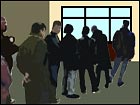|
U.S. jobless claims dip
|
 |
November 15, 2001: 10:08 a.m. ET
New filings fall but continued claims at highest in nearly 19 years.
|
NEW YORK (CNN/Money) - New jobless claims fell in the United States last week, but the number of people receiving unemployment benefits stood at the highest level in nearly 19 years, the government said Thursday.
The Labor Department reported that new jobless claims fell to 444,000 for the week ended Nov. 10 from a revised 452,000 a week earlier. Economists surveyed by Briefing.com expected 475,000 new claims.
"For the second straight week, jobless claims have substantially undershot the consensus," said Ian Shepherdson, chief U.S. economist at High Frequency Economics Ltd. "Analysts apparently do not want to accept that the flow of extra job losses caused by the events of Sept. 11 is slowing sharply, but that is exactly what the data indicate."
The four-week moving average of new claims, which smoothes out the fluctuations in the weekly data, also fell to 474,750 from a revised 487,750 the prior week.
Still, employers aren't yet hiring new workers. Continued claims, the number of workers who have been claiming benefits for at least a week, jumped to 3.83 million in the week ended Nov. 3, the last data available, from a revised 3.70 million the prior week. It was the highest since mid-February 1983.
U.S. stocks were mixed in early trading, while U.S. Treasury bond prices fell yet again Wednesday.
To keep consumers spending despite rising unemployment, which stood at 5.4 percent in October, the Federal Reserve has cut its target for short-term interest rates a record 10 times this year.
Still, many economists expect a recession, commonly defined as two consecutive quarters of shrinking gross domestic product (GDP), to follow the Sept. 11 terror attacks. GDP shrank at a 0.4 percent rate in the third quarter and is widely expected to fare worse in the fourth quarter.
The economy was weak before the attacks, largely because businesses stopped spending money, leading to reduced demand, a manufacturing recession and a pile-up of inventories on manufacturers' shelves.
But businesses began to work off some of that inventory last summer and that continued in September, according to a separate Commerce Department report Thursday. Business inventories fell 0.5 percent, versus forecasts for a 0.3 percent drop and August's 0.1 percent decline.
Click here for CNNmoney.com's economic calendar
And businesses managed to pare inventory even though sales fell 2.8 percent in September, the department said, as businesses slashed production even further.
"In the short-run this will dampen economic activity" as companies continue working off their stockpile of goods, said Steven Wood, economist with FinancialOxygen. "However, once inventory liquidation ends, it will provide a powerful stimulus for economic expansion."
Once businesses boost production, they usually need workers. But the unemployment rate often keeps rising even as the economy starts to recover, since most businesses delay hiring at first to see if the recovery is genuine.
For this reason, many economists say unemployment will rise to 6 percent and possibly higher even as the economy starts growing again next year. They hope the Fed rate cuts and a multi-billion-dollar stimulus package from Congress will boost consumer spending, which fuels two-thirds of GDP, until the job cuts stop. 
|
|
|
|
|
|

|

